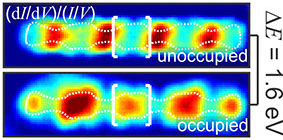Modeling the electronic structure of low-dimensional materials
Supramolecular and metal-organic self-assembly on surfaces holds promise for the synthesis of functional low-dimensional nanostructures with ultimate atomic-scale precision. This approach consists of depositing atoms and functionalised organic molecules onto clean surfaces, in a controlled environment, to achieve well-defined configurations via programmed inter-adsorbate and adsorbate-surface interactions.
Potential functionality of these nano-assemblies arise from their atomic-scale electronic structure, which is dictated by quantum mechanics. Understanding and predicting such electronic structure is non-trivial, given the typically large size of the unit cell of these many-body systems. Density functional theory (DFT) offers a viable numerical method for determining the energy-dependent electronic density in such systems, allowing to understand and predict their morphology and electronic properties at the atomic scale.
The project here consists of using computational DFT tools for determining the atomic-scale morphology and electronic structure of low-dimensional nanostructures on surfaces. Systems of interest will consist of 1D and 2D metal-organic frameworks on metals, semiconductors and atomically thin materials. In particular, these systems are relevant for the design of solid interfaces with functionality in photovoltaics, photocatalysis, molecular nanoelectronics and molecular magnetism.
Applicants for a PhD position should hold an Honours or Master’s degree, and have a strong background in experimental physics.
Please contact us if you have any questions.

